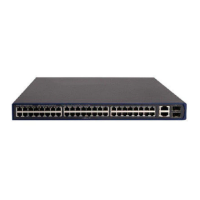26
2. Configure Device C:
# Configure Device C to work in broadcast server mode and send broadcast messages through
VLAN-interface 2.
[DeviceC] interface vlan-interface 2
[DeviceC-Vlan-interface2] ntp-service broadcast-server
3. Configure Device A:
# Configure Device A to work in broadcast client mode and receive broadcast messages on
VLAN-interface 2.
<DeviceA> system-view
[DeviceA] interface vlan-interface 2
[DeviceA-Vlan-interface2] ntp-service broadcast-client
4. Configure Device B:
# Configure Device B to work in broadcast client mode and receive broadcast messages on
VLAN-interface 2.
<DeviceB> system-view
[DeviceB] interface vlan-interface 2
[DeviceB-Vlan-interface2] ntp-service broadcast-client
Device A and Device B get synchronized upon receiving a broadcast message from Device C.
# Take Device A as an example. View the NTP status of Device A after clock synchronization.
[DeviceA-Vlan-interface2] display ntp-service status
Clock status: synchronized
Clock stratum: 3
Reference clock ID: 3.0.1.31
Nominal frequency: 64.0000 Hz
Actual frequency: 64.0000 Hz
Clock precision: 2^7
Clock offset: 0.0000 ms
Root delay: 31.00 ms
Root dispersion: 8.31 ms
Peer dispersion: 34.30 ms
Reference time: 16:01:51.713 UTC Sep 19 2005 (C6D95F6F.B6872B02)
As shown above, Device A has been synchronized to Device C, and the clock stratum level of Device A
is 3, while that of Device C is 2.
# View the NTP session information of Device A, which shows that an association has been set up
between Device A and Device C.
[DeviceA-Vlan-interface2] display ntp-service sessions
source reference stra reach poll now offset delay disper
**************************************************************************
[1234] 3.0.1.31 127.127.1.0 2 254 64 62 -16.0 32.0 16.6
note: 1 source(master),2 source(peer),3 selected,4 candidate,5 configured
Total associations : 1

